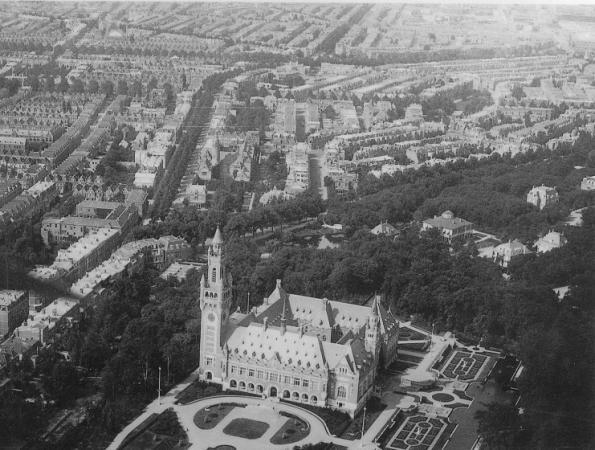The Treaty for the Pacific Settlement of International Disputes, concluded on 29 July 1899, determined that the newly created Permanent Court of Arbitration was to be established at The Hague. As Andrew Carnegie’s gift of 1903 was meant primarily for the erection of a new and appealing court house and library to serve its arbiters, there could be no argument, as to where this ‘Temple for Peace’ was to be built. It should be at The Hague. But where in The Hague precisely was quite another thing.
It was Andrew Carnegie himself who had expressly wished the Dutch Government to select an appropriate site. Nevertheless, a lot of people also made suggestions to this end. Andrew D. White, the former head of the American delegation at the 1899 Peace Conference, for instance, had opted for a site in the ‘Haagse Bos, preferably at the end of that beautiful colonnade of trees running from the Voorhout in the direction of the Palace Huis ten Bosch’. White had not anticipated any problems in these respects. In fact, at the time he thought things could be settled in a single interview with young Queen Wilhelmina. But things went quite differently.
Delay was certainly not due to the Dutch Goverment. The cabinet was quite prepared to be of assistance in any way it could, although matters were complicated though by the sheer fact that the Dutch State simply did not possess any suitable grounds in the area. As news of the parliamentary deliberations on the issue spread to the general public, all kinds of suggestions and offers were put forward spontaneously from everywhere. It soon became evident that a prepatory commission was required here. However, finding a suitable site for the ‘Temple for Peace’ proved to be a real problem and ended in long-term stalemate. To bystanders it must have remained a puzzle as to how the Hague Community could have raised so many objections to each of the suggested sites. In particular, the proposed site of the Malieveld, the time-honoured drill-ground for the army, caused serious clamour on both the part of the military authorities and of The Hague municipal council. In the end it would take the newly constituted Board of the Carnegie Foundation to settle the matter for once and for all.
The Zorgvliet Area Option
At a meeting of the Board on 24 January 1905 a communication was brougth forward from the Park Zorgvliet Company, which was prepared to put a section of its territory, between Oude Scheveningseweg and Groot Hertoginnelaan, at the disposal of the Carnegie Foundation. Gradually but definitely the focus was on this Zorgvliet area, originally prefered by the prepatory commission in 1904. This site offered advantages: it was already provided with a full-grown wood and was very favourably situated. The price of Dfl. 700,000 for the 5 hectares (12 acres) was considered reasonable.
The Zorgvliet Area had a long and interesting history. It was a large, old, private estate located between The Hague and the fishing village of Scheveningen. It was founded by the famous Dutch politician and writer Jacob Cats in the 17th century. It still exists but is much smaller than it once was. The old mansion, known as "Catshuis", is now the official residence of the Dutch prime minister. Zorgvliet had long been the property of aristocrats and royalty. Dutch King Willem II (1742-1849) and his Russian spouse, Grand Duchess Anna Paulovna (1795-1865), had a small and well-loved summer palace, known as "Buitenrust", in this wooded area in the 19th century. After her husband passed away, the dowager queen remained there for the rest of her life.
Bur definitive disadvantages also offered themselves here. The first objection to overcome was the fact that, at the last purchase in 1895, it had been stipulated that no building activities were to take place on the grounds within a term of fifteen years, which therefore expired in 1910 only. Another thing was the nearby "Rustenburg" villa with its Russian orthodox chapel. Queen Anna Palovna initially had this chapel installed here for private use. It was here the Russian delegation attended mass on the opening of the Peace Conference in 1899. Could this chapel be demolished without offering a proper alternative to the Russian orthodox community in The Hague? Both objections were overcome in the course of negotiations. The purchase of the site itself was effected on 18 August 1905 after a long odyssey of exactly two years. Andrew Carnegie, who had been furious over the delay, in a letter expressed himself reassured by the news from relatives who had visited the site. An additional adjacent strip of land of about a hectare would be purchased in 1908. It would be the last extension of the grounds. The "Buitenrust" Palace and "Rustenburg" villa had their swan song and finally had to give way to the construction of the Peace Palace and the landscaping of its gardens.
